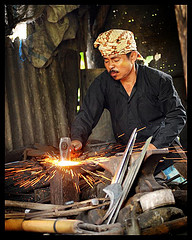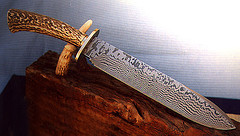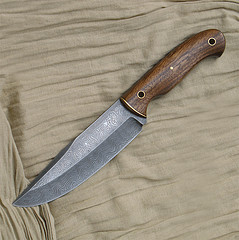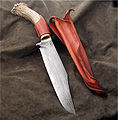
"Damascus Knives"
If You Don't Own One, You May Not Know What They Are.

I think if I try to tell you the history of Damascus knives that I essentially will repeat the same story that you have already heard, and know from the other Damascus pages.
So how about I do this for you. Let’s talk about how Damascus knives are made modern day and see if we can learn something from that.
Sometime soon, I’m going to try to go over the blacksmithing and forging process with you. I’m not sure if it will be on this page or another but if it fits in the subject then we will just let it roll. Ok then, here we go.
"A Brief Disclaimer For Your General Knowledge"

I think that it’s a good idea to let you know that modern day Damascus knives are not the same as the ones from the good old, or bad old days depending on what way you look at it.
As we already explained on other Damascus pages, it is a lost art and it has never been able to be perfectly recreated.
Though it's a good try and for the most part, they tend to be a bit more beautiful than the steel of the past. That doesn’t make them better but it does give them a bit of life.
If a person tries to sell you a Damascus knife, that is not a relic and they claim it to be authentic then don’t let them babysit the kids either. They have already lied to you from the start.
"The Process"

The process has been around for thousands of years and those that are trying their best to create an authentic item for you, are replicating the steel the best they can, the way it was made in the past, but doing so with a bit of modern technology.
I’m not going to hold it against them and neither should you. They are all artists in their craft and genuinely have a passion for what they do.
We should thank them for their time and not ridicule then for it. To start, the process of producing a Damascus knife is called pattern welding.
If you don’t have the drive to wax your truck, you probably do not want to take up blacksmithing. It is a tedious process but with much reward.
Pattern welding is taking multiple layers of metal, folding them together, and bonding them by forge welding. What this does, or what it should do depending on your degree of expertise, is give you a nice blade that is both hard and flexible.
 It also gives you that awesome Damascus steel look that we all want to have in our collection. I am going to write about the forging sometime. I become more interested in it every minute! I have seen some guys make the “wootz” that is used to produce these Damascus knives and they are really into this whole thing.
It also gives you that awesome Damascus steel look that we all want to have in our collection. I am going to write about the forging sometime. I become more interested in it every minute! I have seen some guys make the “wootz” that is used to produce these Damascus knives and they are really into this whole thing.
I am going to try to feature them here some day or at the very least get them to give me an interview. They must have a lot to bring into the discussion, of that I am sure.
Getting the exact carbon content in the mixture for the steel is a pain in the, you know what. If you get too much carbon, you got a pile of cast iron on your hands and if it is too little then you have a pile of wrought iron. So today we use a bit of both.
"Forging And Finishing"

As I was saying, today the forging requires a little bit of this and a little bit of that.
You are typically going to need more of the medium carbon pieces of steel, putting them together and holding them with a steel wire until the first weld is in place.
The pieces are thinned out drastically, and then removed from the furnace where the blacksmith folds the steel over and over; most commonly you will have over 500 layers when the smith is done.
The folding and adding of the layers are what makes the steel strong. The whole process is what causes the steel to be as great as it is. The process gives you a sharper blade than that of other common steels.

Finally, after the blade of the Damascus knives are shaped, they are placed back into the furnace until it reaches a temperature of 1500 degrees.
After, it is removed and is bathed down in oil. What some refer to as the oil bath? The blade then needs to be tempered so it is heated back to 425 degrees for about 2 hours.
After it cools, it is sanded with fine sandpaper and sharpened. The etching in the blade is done by using a mix of acid and water to eat away the softer metal revealing that Damascus steel look and feel.
Wow, that is a lot for us to digest in one session but I will try to cover more as we go into other Damascus product. I’m in hopes I can put you in touch with the best of the blacksmiths that create the best of the Damascus knives. Soon we will be making that attempt. You will want to own one of these steel items, if not for the durability, then certainly for the beauty. You will stare at them for hours at a time.
Damascus Knives To Home Page
Handcrafted Wedding Rings
Damascus Swords
Damascus Steel